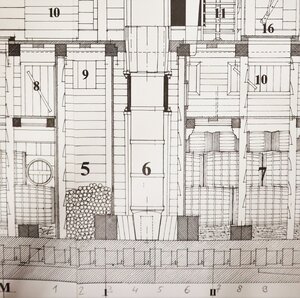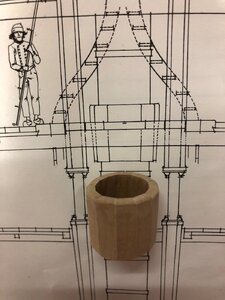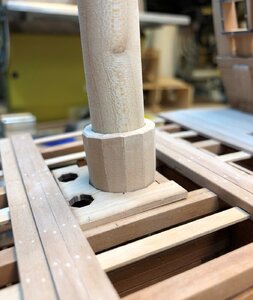What is the name of the round piece that goes at the base of the mast to cover voids and get a snug fit? and where can I find various sizes.? Thank you.
You are using an out of date browser. It may not display this or other websites correctly.
You should upgrade or use an alternative browser.
You should upgrade or use an alternative browser.
I saw somewhere someone called them "mast wedges"?What is the name of the round piece that goes at the base of the mast to cover voids and get a snug fit? and where can I find various sizes.? Thank you.
Yes they are mast wedges, on real ship's they were usually covered with canvas nailed to the mast and deck and then painted to ensure that they were water tight,
Best regards John,
Best regards John,
I’ve never seen mast wedges offered anywhere.
I believe they are almost always specific to the mast as well as the size of the “hole” in the deck. As such, you would have to custom fit them to both sides, the mast (usually a radius..) and the hole in the deck (could be anything..).
Also, since the masts are almost always on a bit of a “rake”, the wedges could be different sizes on different sides of the mast.
I believe they are almost always specific to the mast as well as the size of the “hole” in the deck. As such, you would have to custom fit them to both sides, the mast (usually a radius..) and the hole in the deck (could be anything..).
Also, since the masts are almost always on a bit of a “rake”, the wedges could be different sizes on different sides of the mast.
Hi Ken s!
The mast is inserted in a square bearing at the bottom of the fuselage and is thus secured against twisting. There are mast wedges to brace the mast each time it passes through a deck. If masts have to replaced, the wedges can be removed. Some kit manufacturers put wooden oder brass rings in their kits to simulate this. Whoever wants to can of course make them themselves in different designs.
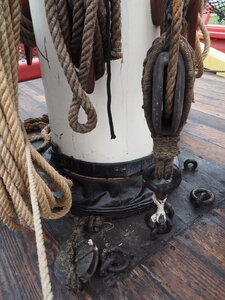
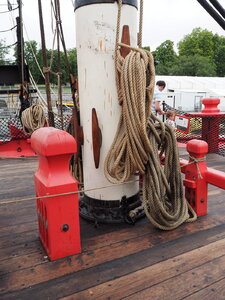
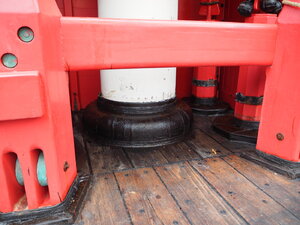
They are covered and tarred to protect them from moisture.
With best regards
Thomas
The mast is inserted in a square bearing at the bottom of the fuselage and is thus secured against twisting. There are mast wedges to brace the mast each time it passes through a deck. If masts have to replaced, the wedges can be removed. Some kit manufacturers put wooden oder brass rings in their kits to simulate this. Whoever wants to can of course make them themselves in different designs.



They are covered and tarred to protect them from moisture.
With best regards
Thomas
Thank you everyone for the info. In kits in the past, they always supplies a round wooden ring with a hole for the diameter. Guess I'll be making my own on this one.
The Mast Partners is the strong wood or beams around the mast opening against the wedges were pressed - means wedges are pressed between the mast and the partnersI think they are called 'mast partners'.
János
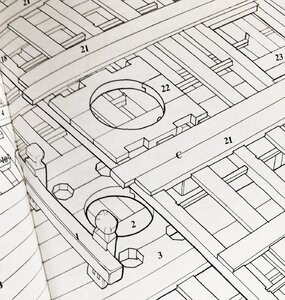
No. 22 are the "partners"
Here shown are the wedges pressed between the mast and the partners to fix the mast - with removing the wedges the mast is free and can be lifted
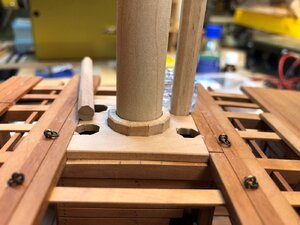
a good sketch you can find also here
Maybe you can enlighten me a little more. What are the hexagonal dowels?The Mast Partners is the strong wood or beams around the mast opening against the wedges were pressed - means wedges are pressed between the mast and the partners
View attachment 174046
No. 22 are the "partners"
Here shown are the wedges pressed between the mast and the partners to fix the mast - with removing the wedges the mast is free and can be lifted
View attachment 174045
a good sketch you can find also here
These dowels are octagonal and are the pumpsMaybe you can enlighten me a little more. What are the hexagonal dowels?
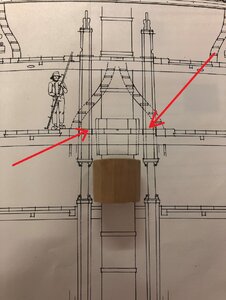
In the photo of the last post you can see this area, shown with the red arrows.
Due to easier construction method of the model I made a cut at this level - in reality these dowels went through the mast partners
You can find this in my building log of the Bonhomme Richard
USS BONHOMME RICHARD - POF - Cross Section in Pear - 1:48 - by Uwe
Yesterday I started the first activities on my section model - in order to warm up At the end it should look like this a kit review you can find here...
shipsofscale.com
Thanks for asking this.!! You beat me to it.!Maybe you can enlighten me a little more. What are the hexagonal dowels?
Because everyone likes to see pictures.
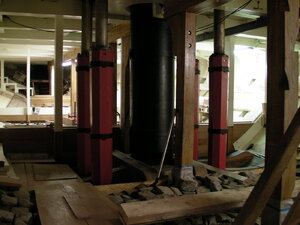
The four pumps of the Hermione replica in ballast.
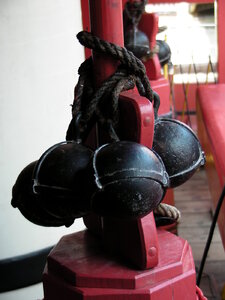
Pump weights on the gun deck to hold down.
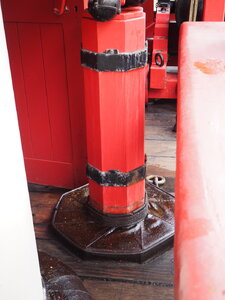
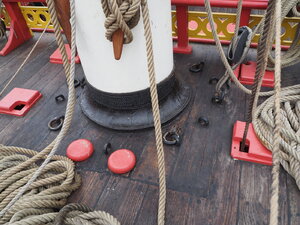
At the top you can only see the openings for the four pumps below.
With this type of pump, the long pump levers were suspended from the mast with ropes. On one side the crew pulled, on the other side the pump lever of the pump located one deck below pulled up by a rope for suction. On the right front of the picture you can see the rope through the deck to the pump.
With best regards
Thomas

The four pumps of the Hermione replica in ballast.

Pump weights on the gun deck to hold down.


At the top you can only see the openings for the four pumps below.
With this type of pump, the long pump levers were suspended from the mast with ropes. On one side the crew pulled, on the other side the pump lever of the pump located one deck below pulled up by a rope for suction. On the right front of the picture you can see the rope through the deck to the pump.
With best regards
Thomas
Last edited:
Most model kits use a round ring, wood or brittania metal, to simulate the canvas mast wedge coverings. You can get these rings in several sizes from most hobby web sites featuring historic ship fittings. For example, search fittings in “Ages of Sail.“ These mast rings are meant to simulate the final canvas coverings that are fitted over and around mast wedges. For modeling your end goal is to simulate the canvas covering. I usually fit a mast tightly through the deck...glue in place...then model a canvas covering around the mast where it passes through the deck with either a ring painted dark brown or a piece of sail cloth glued in place and also painted.
Last edited:
- Joined
- Dec 24, 2019
- Messages
- 169
- Points
- 113

Some modern sailing vessels (ones that have their masts stepped on the keel — as opposed to deck stepped) still use mast wedges. I made my first ones out of oak (for a 25’ sailboat). They cracked after sailing in heavier winds. The next ones I made out of fir. They were still in use years later when I sold the boat. The mast coat covered them and stopped the deck leaking.





